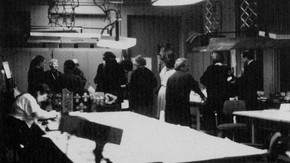Conservation Journal
April 1992 Issue 03
Conservation Study Day at the V&A 1991
The Conservation Department opened its doors to a paying public for the second time on December 6 1991. The first occasion had been December 1990 when forty members of the public visited the Department over a two day event. It had been considered worthwhile enough to warrant another attempt.
In 1990 a questionnaire had been passed to delegates in an effort to identify the market, its expectations and opinions. The response indicated that all the delegates would be interested in attending further Conservation Open Days.
As with any conference, study day or visit, particularly where large groups of people are involved, there are inevitably snags. Inconveniences such as insufficient coffee cups, inadequate toilet facilities and a temperamental audio system in the lecture theatre were a few of the points listed under 'Further Comments' on the questionnaire, for both the 1990 and 1991 event.
The disruption to work and time involved for the sections was a matter for concern. In pursuing a popular approach one has to balance the time and energy invested against presumed or realized benefits.
However the response had been positive and a repeat one day event was planned for 1991 involving all conservation sections. Maximum numbers were set in order to accommodate studio visits safely, resulting in an audience of 93 members of the public paying £35. Each person received four lectures on the work of the Department and two tours to selected sections. The visits to sections, which were felt to be too short in 1990, were increased from 30 minutes to 45 minutes in 1991, being a better length of time for conservators to talk about the studios and their work.
The questionnaires for both 1990 and 1991 indicated a range of reasons for people attending, from general to professional interest, to those considering a career in conservation as well as careers advisors. There is certainly a potential for identifying specific target groups and tailoring the visits accordingly should this be desired.
So, what are the benefits of hosting an obviously expensive event such as this? Well, it made money and with wider advertising it could raise a larger audience. Calculations suggest up to 240 delegates could be accommodated by the Department. Public relations was definitely an identifiable benefit, with the potential of attracting sponsorship.
Perhaps though, one of the most surprising benefits was the effect the day had on conservators themselves. There was no doubt about it, there is a certain exhilaration to be gained by talking about your chosen profession to an interested audience. I wasn't the only one who went home on Friday 6 December exhausted and elated.
The next Conservation Study Day is planned for December 1992.
April 1992 Issue 03
- Editorial - What is Research?
- The Resurrection of Death on a Pale Horse
- Vessel Glass Deterioration in the Museum Environment: A Quantitative Study by Surface Analysis
- The Mounting and Framing of a Large Work of Art on Paper; a Case Study
- Graphic Descriptions: Side-lights from Manuscript Sources on English Drawing Materials
- Conservation Study Day at the V&A 1991
- Assessment on the RCA/V&A Conservation Course: Essays, Proposals and Projects
